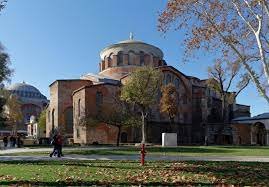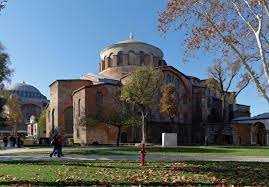One of the most surprising finds in my time in Istanbul, Turkey was finding Hagia Irene (Aya Irini). Hidden away within the vast complex of Topkapi Palace, I almost missed this simple, yet introspective jewel of the past on Day 1 of my journey there.

My research on Topkapi Palace indicated that the best tour package available was the Combo Pass: entry into the Palace, the Harem, and Hagia Irene for 285 Turkish Lira, or about $31 USD. The Palace is the main attraction; a series of beautiful buildings that served as the royal court of the Ottoman Empires' many Sultans over their 600-year reign. The Harem was the personal residences of the Sultans, their families, servants, and wives.
I was primarily concerned with gaining access to both the Palace and the Harem. These seemed to be the most popular and discussed elements of the tour. And as I completed my amazing tour of those areas over the course of several hours, I had all but decided to skip the Hagia Irene, being told it was not worth seeing.
But as I was making my way out of the sprawling complex, one of the many calls to prayer that lilt out from the many Mosques started up. I set my camera phone to record, and followed the song across the compound, searching for the origin. And it was this enchanting song from the Muezzins calling their flock to prayer that led me to the non-descript, almost hidden door of Hagia Irene.

Set between two bored Museum clerks, the entry to Hagia Irene is anything but impressive. A simple, dark opening in the bricked wall led down a gentle descent into the Hagia. As I approached them, the uninterested looks of clerks suddenly turned to mild surprise. They checked my ticket, and then waved me in. As it turned out, I would be the only person inside.

Damp, darkened, and dusty, the long slope of the cement walkway led me down into the chamber below. This place was obviously not regarded as anything worth celebrating, since its upkeep was nothing compared to the Palace. But as I reached the bottom, and turned around the pillar of the first arches, I saw the first streams of light falling through a mesh net strung across the ceiling above.
At first, I believed the netting was a part of some kind of renovation occurring within. The condition of the interior, however, quickly extinguished this possibility. I realized that the woven mesh was simply to prevent stone chips from reigning down upon any bystanders who might be wandering around below. And given the amount of material trapped, suspended in these nets, it was surely a wise precaution.
A giant arch set high in the roof of this old religious monument to antiquity invited in golden light as it has for sixteen centuries. Not even the netting could hold back these beams from illuminating the interior, which boldly brushed back the shadows.
And then the rich history of this forgotten place suddenly spoke loudly, but without words.
Set into the far wall was a large multi-tiered alter. Three massive arched windows pushed light down onto the stone floor, setting it afire. Simple, unadorned, but majestic was this alter: an Eastern Orthodox alter in construction.

Built in 337 AD, Hagia Irene was constructed under orders of Constantine I, the first Roman Emperor to convert to Christianity. And since it was never converted to a Mosque, as were most other Greek and Roman churches built in Constantinople, now Istanbul, the tiled cross set into the curve of the dome was never removed or disfigured.
Standing completely alone inside this church, with no other visitors, guides, or Museum workers within it, I stood amazed.

Perhaps the Ottomans, victors in their eventual conquest of Constantinople, didn't have time to remove this cross set high in the atrium of this ancient cathedral. Or, perhaps the work to remove the cross proved too difficult. I seriously doubt either scenario, however.
We do know, though, that this place was never used for worship following Constantinople's fall. It was used to store weapons for some time; a rather ironic prospect. Perhaps, set upon building their new city, the gateway between Europe and Asia, the Ottomans had more important considerations when solidifying their hold on this important ground.
Either way, this cross serves as a reminder that no matter how strong, how brave, or how successful we may become our eventual end is, at some point, assured.

All photos in this post are mine save this last of the exterior of Hagia Irene. Since I had stumbled upon the entrance to this church, I had taken no photos leading up to my entering it. I suppose I have little excuse for not photographing it upon my exit, but such is life, my friends.
Cheers!

Congratulations, your post has been added to Pinmapple! 🎉🥳🍍
Did you know you have your own profile map?
And every post has their own map too!
Want to have your post on the map too?
Congratulations @braveboat! You received the biggest smile and some love from TravelFeed! Keep up the amazing blog. 😍 Your post was also chosen as top pick of the day and is now featured on the TravelFeed.io front page.
Thanks for using TravelFeed!
@for91days (TravelFeed team)
PS: TravelFeed is in social media to reach more people, follow us on Facebook, Instagram, and Twitter.
Hiya, @LivingUKTaiwan here, just swinging by to let you know that this post made it into our Honorable Mentions in Daily Travel Digest #1357.
Your post has been manually curated by the @pinmapple team. If you like what we're doing, please drop by to check out all the rest of today's great posts and consider supporting other authors like yourself and us so we can keep the project going!
Become part of our travel community: